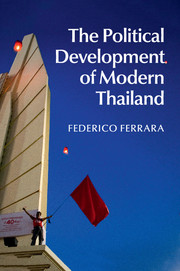Book contents
- Half title page
- Title page
- Copyright page
- Dedication
- Dedication
- Contents
- Contents
- Frontispiece
- Preface
- 1 Unfinished business
- 2 The birth of ‘Thainess’
- 3 Revolution forsworn
- 4 The age of betrayal
- 5 The good dictatorship
- 6 Rise of the politicians
- 7 Barbarians at the gate
- 8 State of unexception
- Bibliography
- Index
- References
Bibliography
Published online by Cambridge University Press: 05 May 2015
- Half title page
- Title page
- Copyright page
- Dedication
- Dedication
- Contents
- Contents
- Frontispiece
- Preface
- 1 Unfinished business
- 2 The birth of ‘Thainess’
- 3 Revolution forsworn
- 4 The age of betrayal
- 5 The good dictatorship
- 6 Rise of the politicians
- 7 Barbarians at the gate
- 8 State of unexception
- Bibliography
- Index
- References
Summary

- Type
- Chapter
- Information
- The Political Development of Modern Thailand , pp. 296 - 322Publisher: Cambridge University PressPrint publication year: 2015

